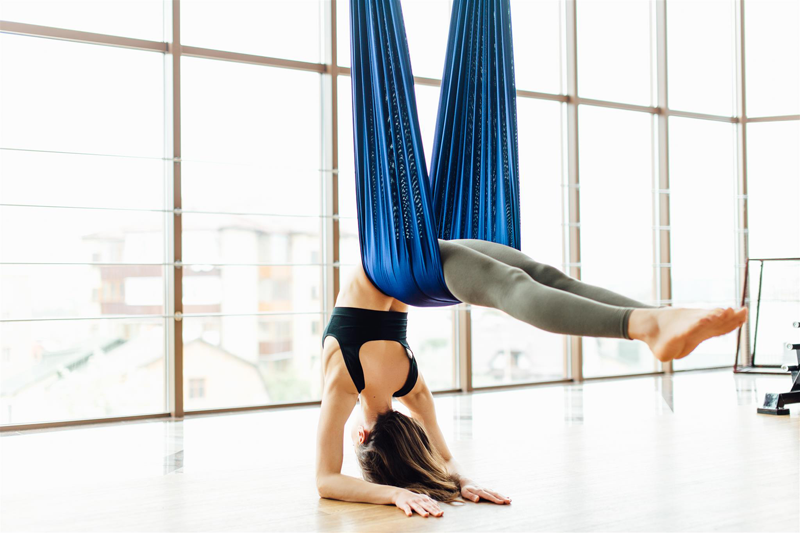Fly Yoga, or ‘Aerial Yoga’, is a relatively new style of yoga. The practice uses a hammock to combine traditional yoga postures with pilates and dance. Designed to support up to 300 kilos of weight, the hammock allows practitioners of all sorts to partake in the practice. The sturdy contraption consists of industrial support chains, carabiners, and a webbing strap. While this may sound a little uncomfortable, the hammock itself is constructed from good-quality silk for a pleasant experience. The support chains hang down from the ceiling to the floor, so practitioners can connect the hammock at their preferred height using carabiners. As the hammock provides full body support, Fly Yoga is popular amongst those with weaker joints, back problems, and hip pain. Better still, every Fly Yoga class is equipped with a range of apparatus. All you need to bring is yourself and some comfortable yoga clothes. Below, we explore the practice in more detail.
History and Origins
The use of props in yoga was introduced by yoga guru, B.K.S. Iyengar. Though other yogis may have been using natural equipment in their practice before this, Iygengar encouraged students to use a range of props including straps, ropes, chairs, blocks, and slings. Iyengar’s sling was later developed by Physical Therapist, Antonio Cardenas. In 2001, this creation was labelled the ‘Yoga Swing’. In 2003, Kerrie Neal released the ‘Gravotonics Yoga Swing & Exercise System’, which became popular in yoga classes around Indonesia. Founder of ‘YogaBody’, Lucas Rockwood, first used this inversion swing in 2004, but quickly became frustrated with the design. This experience led him to develop the ‘Yoga Trapeze’. In 2011, British yogi, Richard Holroyd, decided to open the UK’s first Fly Yoga studio. Named Aerial Yoga London, the practice was run by Holroyd himself and featured Lucas Rockwood’s ‘Yoga Trapeze’. In 2017, Holroyd decided to move to India to develop and expand the Fly Yoga practice. A wide range of Fly Yoga studios can now be found worldwide.
Benefits
Cardio Workout
During a Fly Yoga session, almost all of your body is forced to engage. Not only does this allow the muscles to become more toned and defined, but it also improves joint strength and stability. Fly Yoga is also a great form of cardio. In just one session, students are expected to burn an average of 320 calories. This makes the exercise comparable to cycling or power walking.
Great Fun
In addition to boasting a range of physical benefits, Fly Yoga is great fun. Many students attend weekly Fly Yoga sessions purely for pleasure. It’s not often that you get the opportunity to perform gymnastics tricks, but Fly Yoga allows you to play acrobat every week. The playful nature of the practice encourages students to return each session. It’s no secret that if you enjoy your exercise regime, you’re more likely to stick with it.
Relieves Stress
Like most forms of yoga, Fly Yoga is ideal for relieving stress. Helping to clear the mind, the practice can help students to rebuild their emotional system. The meditative state of each session helps to combat stress and increase creativity; this allows practitioners to leave the class feeling relaxed, rejuvenated and inspired.
Improves Flexibility
By counteracting gravity, Fly Yoga allows you to move freely between postures. Being suspended in the air encourages the body to release tension in the muscles and bones, which leads to an increase in flexibility after just a few sessions. The suspension also helps to tone the stomach by strengthening the abdominal muscles.
Reduces Back Pain
Fly Yoga can also help to reduce back pain of all sorts. Hanging freely in the air allows the spine to lengthen. Additionally, the suspension prevents strain on your back and tension on the spinal cord; this allows practitioners to perform a deeper stretch without causing discomfort.
Improves Strength
Fly Yoga can improve strength throughout the body. In addition to being useful in the practice, stronger muscles can beneficial in day-to-day life, too. Helping to increase stamina and encourage faster recovery, Fly Yoga is often practised by long distance runners and other athletes.
Boosts Mood
Releasing a range of ‘happy hormones’ including endorphins, serotonin, and dopamine, Fly Yoga can help to boost your mood. Additionally, the suspension gets your adrenaline going. This can improve your energy levels and reduce fatigue.
Benefits Digestion
Fly Yoga stretches are great for improving digestion. Regular practice of Fly Yoga can help to combat a range of digestive issues, including diarrhoea, constipation, bloating, and indigestion.
Combats Symptoms of Ageing
By improving blood circulation, Fly Yoga can help to combat symptoms of ageing. Additionally, the practice cleanses the circulatory and lymphatic systems. This process can prevent the onset of cardiovascular issues.
Improves Memory
By fortifying your neural connections, Fly Yoga can help to improve your memory.
In Summary
Whether you’re an experienced yogi or a complete beginner, Fly Yoga can be a great form of exercise. The practice can be easily adapted to different abilities, making the sessions suitable for practitioners of all sorts. Better still, the practice is regarded as on the of the most enjoyable styles of yoga. Unfortunately, Fly Yoga isn’t something that can be practised from home. To enjoy the style, you will need to pop along to a local class. Here, an experienced instructor will help you get to grips with the different equipment to avoid unnecessary injury from occurring. Additionally, the instructor will be able to advise you on which postures to begin with. While all the apparatus is provided, it’s a good idea to go equipped with some flexible yoga pants to get the most out of your session.

